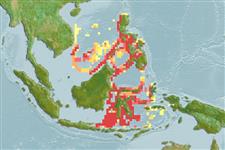>
Notacanthiformes (Halosaurs and deep-sea spiny eels) >
Halosauridae (Halosaurs)
Etymology: Halosaurus: Greek, als, alis = salt + Greek, sauros = lizard (Ref. 45335).
Eponymy: Robert Ridgway (1850–1929) was an American ornithologist. [...] (Ref. 128868), visit book page.
More on author: Fowler.
Environment: milieu / climate zone / गहराई सीमा / distribution range
पारिस्थितिकी
समुद्री बाथीड़िमरसल; गहराई सीमा ? - 706 m (Ref. 280). Deep-water
Western Central Pacific.
आकार / वज़न / Age
परिपक्व अवधि: Lm ? range ? - ? cm
Bottom feeders; mainly on crustaceans and other small invertebrates. Males with markedly enlarged olfactory organs at maturity. Leptocephalus larvae pelagic. Taken occasionally in deep bottom trawls (Ref. 12887).
Life cycle and mating behavior
परिपक्व अवधि | पुनरुत्पत्ति | मछलीऔ का अंडे देना | अंडे | Fecundity | लार्वा
Smith, D.G., 1999. Halosauridae. Halosaurus. p. 1625-1626. In K.E. Carpenter and V.H. Niem (eds.) FAO species identification guide for fishery purposes. The living marine resources of the WCP. Vol. 3. Batoid fishes, chimaeras and bony fishes part 1 (Elopidae to Linophrynidae). FAO, Rome. (Ref. 12887)
IUCN Red List Status (Ref. 130435: Version 2025-1)
Threat to humans
Harmless
Human uses
मात्स्यिकी: कोई रुचि बग़ैर
साधन
Special reports
Download XML
इंटरनेट स्रोत
Estimates based on models
Preferred temperature (संदर्भ
123201): 8.8 - 12.4, mean 11.1 °C (based on 19 cells).
Phylogenetic diversity index (संदर्भ
82804): PD
50 = 0.5020 [Uniqueness, from 0.5 = low to 2.0 = high].
Bayesian length-weight: a=0.00085 (0.00033 - 0.00223), b=3.07 (2.84 - 3.30), in cm total length, based on LWR estimates for this (Sub)family-body shape (Ref.
93245).
Trophic level (संदर्भ
69278): 3.4 ±0.4 se; based on size and trophs of closest relatives
लौटाव (संदर्भ
120179): माध्यम, न्यूनतम जनसंख्या दुगनी होने का समय 1.4 - 4.4 वर्ष। (Preliminary K or Fecundity.).
Fishing Vulnerability (Ref.
59153): Moderate vulnerability (38 of 100).
🛈
